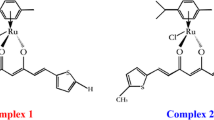Abstract
Curcumin (diferuloyl methane) has a wide range of physiological and pharmacological actions. Curcumin interaction with human serum albumin (HSA) has been followed by fluorescence quenching and circular dichroism (CD) measurements. Based on fluorescence measurements, the equilibrium constant for the interaction is 2.0±0.2×105M−1. Binding of curcumin to HSA induces an extrinsic CD band in the visible region. From the induced CD band measurements, the equilibrium constant has a value of 2.1±0.3×104M−1. Thus, HSA has two kinds of affinity sites for curcumin, one with high affinity and the other with lower affinity. Job’s plot indicated a binding stoichiometry of 1∶1 for the high-affinity site. The equilibrium constant was invariant with temperature in the range of 15 to 45°C, suggesting the role of hydrophobic interactions in the binding of curcumin to HSA. Curcumin does not change the conformation of the HSA molecule. These measurements have implications in the understanding of the curcumin transport under physiological conditions.
Similar content being viewed by others
Abbreviations
- CD:
-
circular dichroism
- HSA:
-
human serum albumin
- Q max :
-
maximal quench
- UV:
-
ultraviolet
References
Govindarajan, V.S. (1980) Turmeric-Chemistry, Technology and Quality, Crit. Rev. Food Sci. Nutr. 12, 199–301.
Srimal, R.C., and Chawan, B.N. (1973) Pharmacology of Diferuloyl Methane (curcumin), a Nonsteroidal Anti-Inflammatory Agent. J. Pharm. Pharmacol. 25, 447–457.
Toda, S., Miyase, T., Arichi, H., Tanizawa, H., and Takino, Y. (1985) Natural Antioxidants. III. Antioxidative Components Isolated from Rhizome of Curcuma longa, L., Chem. Pharm. Bull. 33, 1725–1728.
Mukhopadhya, A., Basu, N., Ghatak, N., and Gujral, P.K. (1982) Anti-Inflammatory and Irritant Activities of Curcumin Analogues in Rats, Agents Actions 12, 508–515.
Pulla Reddy, A.Ch., and Lokesh, B.R. (1994) Effect of Dietary Turmerie (Curcuma longa) on Iron-Induced Lipid Peroxidation in the Rat Liver, Food Chem. Toxicol. 32, 279–283.
Elizabeth, K., and Rao, M.N.A. (1990) Oxygen Radical Scavenging Activity of Curcumin, Int. J. Pharm. 58, 237–240.
Unnikrishnan, M.K., and Rao, M.N.A. (1992) Curcumin Inhibits Nitrite Induced Methemoglobin Formation, FEBS Lett. 301, 195–196.
Nagabhushan, M., Amonkar, A.J., and Bhide, S.U. (1987) In vitro Anti-mutagenecity of Curcumin Against Environmental Mutagens, Food Chem. Toxicol. 25, 545–548.
Huang, M.-T., Wang, Z.Y., Georgiadis, C.A., Laskin, J.D., and Conney, A.H. (1991) Inhibitory Effects of Curcumin on Tumor Initiation by Benz[α]pyrene and 7,12-Dimethyl benz[α]anthracene, Carcinogenesis 13, 2183–2186.
Li, C.J., Zhang, L.J., Dezube, B.J., Crumpacker, C.S., and Pardee, A. (1993) Three Inhibitors of Type I Human Immuno-deficiency Virus Long Terminal Repeat Directed Gene Expression and Virus Replications, Proc. Natl. Acad. Sci. USA 90, 1839–1842.
Huang, M.-T., Smart, R.S., Wong, C.-Q., and Conney, A.H. (1988) Inhibitory Effect of Curcumin, Chlorogenic Acid, Caffeic Acid and Ferulic Acid on Tumor Promotion in Mouse Skin by12-O-Tetra-decanoylphorbol-13-acetate, Cancer. Res. 48, 5941–5946.
Huang, M.-T., Lysz, T., Ferraro, T., Abidi, T.F., Laskin, J.D., and Conney, A.H. (1991) Inhibitory Effects of Curcumin on in vitro Lipoxygenase and Cyclooxygenase Activities in Mouse Epidermis, Cancer Res. 51, 813–819.
Gorman, A.A., Hamblett, I., Hill, T.J., Jones, H., Srinivasan, V.S., and Wood, P.D. (1997) Gurcumin: A Pulse Radiolysis Investigation of the Radical in Micellar Systems, in Spices: Flavor Chemistry and Antioxidant Properties (Risch, S.J., and Howe, C.T., eds.), Vol. 660, pp. 235–243, American Chemical Society, Washington, DC.
Kunchandy, E., and Rao, M.N.A. (1989) Effect of Curcumin on Hydroxyl Radical Generation Through Tocopherols and Tocotrienols, Int. J. Pharm. 57, 173–176.
Deodhar, S.D., Sethi, R., and Srimal, R.C. (1980) Preliminary Study on Anti-Rheumatic Activity of Curcumin (dirferuloyl methane), Ind. J. Med. Res. 701, 632–634.
Srihari Rao, T., Basu, N., and Siddique, H.H. (1982) Anti-Inflammatory Activity of Curcumin Analogues, Ind. J. Med. Res. 75, 574–578.
Ravindranath, V., and Chandrashekar, N. (1982) Metabolism of Curcumin: Studies with 3H-Curcumin, Toxicology 22, 337–344.
Spector, A.A. (1975) Fatty Acid Binding to Plasma Albumin, J. Lipid Res. 16, 165–179.
Tonnesen, H.H., and Greenhill, V.J. (1992) Studies on Curcumin and Curcuminiods: XXII: Curcumin as a Reducing Agent and as a Radical Scavenger, Int. J. Pharm. 87, 79–87.
Lehrer, S.S., and Fasman, J.D. (1966) The Fluorescence of Lysozyme and Lysozyme Substrate Complex, Biochem. Biophys. Res. Commun. 23, 133–138.
Jaffe, H.H., and Orchin, M. (1962) in Theory and Applications of Ultraviolet Spectroscopy, John Wiley, New York, pp. 581–583.
Ikeda, K., and Hamaguchi, K. (1969) The Binding of N-Acetyl-glucose Amine to Lysozyme; Studies on Circular Dichroism, J. Biochem. 66, 513–520.
Maliwal, B.P., Appu Rao, A.G., and Narasinga Rao, M.S. (1985) Spectroscopic Study of the Interaction of Gossypol with Bovine Serum Albumin, Int. J. Pep. Protein Res. 25, 382–388.
Oh, H.I., Hoff, J.E., Armstrong, G.S., and Haff, L.A. (1980) Hydrophobic Interaction in Tannin-Protein Complexes, J. Agric. Food Chem. 28, 394–398.
Haslam, E. (1996) Natural Polyphenols (vegetable tannins) as Drugs: Possible Modes of Action, J. Nat. Prod. 59, 205–215.
Pederson, O.L., and Jacobson, M. (1980) Independent Binding of Ligands to Human Serum Albumin, J. Biol. Chem. 32, 5067–5072.
Appu Rao, A.G. (1992) A Stoichiometric Analysis of Bovine Serum Albumin-Gossypol Interactions: A Fluorescence Quenching Study, Ind. J Biochem Biophys. 29, 179–182.
Peters, T., Jr. (1985) Serum Albumin, Adv. Protein Chem. 37, 161–245.
Jacobson, J., and Brodersen, R. (1983) Albumin-Bilirubin Binding Mechanism, J. Biol. Chem. 258, 6319–6326.
Rechieri, G.V., Anel, A., and Kleinfeld, A.M. (1993) Interaction of Long-Chain Free Fatty Acids and Albumin: Determination of Free Fatty Acid Levels Using the Fluorescent Probe AD-IFAB, Biochemistry 32, 7574–7580.
Began, G., Sudharshan, E., and Appu Rao, A.G. (1998) Inhibition of Lipoxygense 1 by Phosphatidylcholine Micelles-Bound Curcumin, Lipids 33, 1223–1228.
Reddy, S., and Aggarwal, B.B. (1994) Cureumin Is a Competitive and Selective Inhibitor of Phosphorylase Kinase, FEBS Lett. 341, 19–22.
Yamamoto, H., Hanada, K., Kawasaki, K., and Nishijima M. (1997) Inhibitory Effect of Curcumin on Mammalian Phospho-lipase D Activity. FEBS Lett. 417, 196–198.
Author information
Authors and Affiliations
About this article
Cite this article
Pulla Reddy, A.C., Sudharshan, E., Appu Rao, A.G. et al. Interaction of curcumin with human serum albumin—A spectroscopic study. Lipids 34, 1025–1029 (1999). https://doi.org/10.1007/s11745-999-0453-x
Received:
Revised:
Accepted:
Issue Date:
DOI: https://doi.org/10.1007/s11745-999-0453-x



